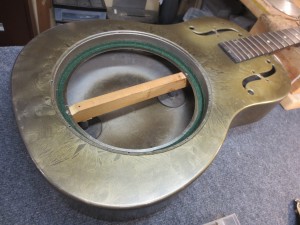We reset the neck on this beautiful mid 30’s Duolian for Wilco frontman Jeff Tweedy.

We’ve been privileged to do some work with Chicago’s hometown heroes, Wilco. This National Duolian dates to the mid 1930’s and is an interesting companion piece to our earlier post about a 30’s National neck reset. A design feature that made that one especially challenging, is remedied in this model – with great results. This guitar was a bit of a surprise to us because one rarely sees resophonic guitars as part of a Wilco set. It was used quite a bit though while recording the new Jeff Tweedy-produced Mavis Staples record “One True Vine.” . To play comfortably, it needed the neck angle reset and the biscuit bridge replaced, but Jeff requested that the modifications stop there to preserve all of the tonal characteristics that drew him to it in the first place. It’s a rather dark-sounding instrument with a richer bass sound than lots of metal-body guitars. Beyond that, the green/gold finish is just beautiful to look at.

So back to that design characteristic I just mentioned – right? Take a close look at the F holes, and you’ll notice that the edges are rounded or rolled – a metal working technique that stiffens the material considerably. This makes the top more stable and able to withstand the pressure and pull of string tension. The two steel supports that hang from the top at right angles (pictured below) help a lot too – replacing the earlier model’s two wooden supports. All in all, it’s a big improvement over the non-rolled design from just a couple of years earlier.


To reset the neck, we removed the resonator cone and neck – which is held in place by an extension stick that runs the length of the body inside.

To kick the angle back to the correct spot, we’ll need to carefully remove some material from both the neck stick (above) and the neck heel (below.)

Next, Dan installs a new National biscuit bridge. The original had been lowered to get the action more playable but at some point one runs out of bridge to lower; that’s when it’s time to reset the neck.

There’s some stringing, unstringing, and restringing involved with getting the neck and bridge aligned correctly. When it’s just right, the cover plate can go back into place.

The playing action is nice and smooth now, with all of the warmth and depth that the guitar had before. Hopefully, Wilco fans will be hearing more from this guitar in the future!



Thanks for this posting. I have a ’36 Triolian that’s in need. I went to the National Resophonic HQ last summer and the showed me their set up but I had just scored a gig opening for Robert Earl Keen and couldn’t leave my dear Rosy with them.
I have a few questions.
What’s the optimal neck angle to get the string break angle correct to the tail piece? Or is it a product of the conditions of each guitar?
Is there a correct way to figure this angle or is it trial and error?
As you put it, “the product of conditions of each guitar.” When we’re repairing a guitar we always have to look at it as an individual instrument – if it needs a steeper angle then that’s what it gets. We make that assessment relative to the bridge/saddle and we do have our basic parameters that we aim for in a general sense but we really have to see what will make a particular guitar feel and sound its best.
Btw, congrats on the gig with REK. He’s great!
I was given a 1937 Trojan, wood bodied resonator with major damage. Just finished the restoration and am thrilled with the result. It was built as were many but not all wood bodies from 37 to 40 with the identical Trolian. Unlike all other pre-war guitars, the models of resonators with this stick are quite simple to disassemble and reassemble without having to “reset” the neck. Mine has a screw at the butt end (holding the strap button), two connected to posts supporting the stick, two below the cone and one under pearloid dot on fretboard among four others connected just to the body. It can be taken apart and reassembled using all of the same holes therefore assuring the same neck set…….mine still played o.k. and has a laser straight neck, aside from having the headstock broken and poorly repaired many years prior to my rebuild.
I have repaired/rebuilt my 37 Trojan. It’s playing well but I’d like to drop the bridge height slightly. National Resophonic told me that they now use a peel and stick felt under the cone so that is what I did though I think the original “gasket” was a thin piece of muslin that has a seam stitched into it that tucked into the rim of the cone. Should I go with a thinner gasket? Shave the biskit? Groove the bridge deeper?
Jeff, we’d really need to see the guitar to say where you should look to make a change for lower action. It depends on how much lower you want to go. Additionally, those guitars usually have a very shallow neck angle to begin with; it’s part of the sound. So any changes to the bridge/saddle or cone area need to be done very carefully to avoid going too low.